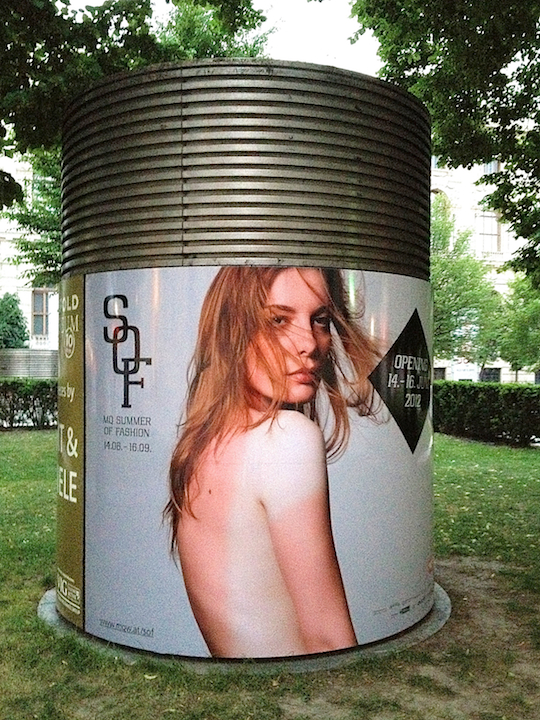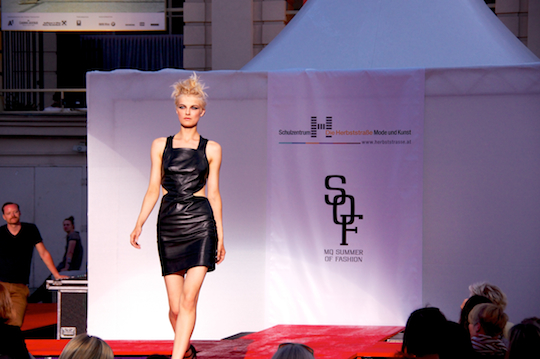The book that Susan Ingram and Markus Reisenleitner have co-authored is a masterpiece which isn’t afraid to own up to its scholarly rigor. Equally satisfying to the coffee table book skimmer as it will be to the serious student of fashion and history, Wiener Chic: a Locational History of Vienna Fashion is a book that attempts to expose the preconditions of history which have given rise to the dynamism of Vienna fashion. The Austrian capital, the authors claim, has been overlooked by the fashion world. But they don’t strive to provide an easy answer. Rather, this book is a testament to the complexities of the history, a multifaceted and complicated one which the authors want to unpack carefully rather than quickly. The book has two major parts: the first is “Chic Formations: The Cinematically Historical Underpinnings of Vienna’s Urban Imaginary,” and the second, “Staging Fashion in Vienna.” Subchapters distinguish between different types of chic-ness, or, different historical elements which contribute to Vienna’s ongoing fashion story. “Vienna is changing,” we’re told in the introduction, “and like Baudelaire’s Paris, when Vienna changes, it changes dramatically and under public scrutiny. These are cities that are not merely states of mind (Park), ways of life (Wirth) or structures of visibility (Donald 1999), but ones that generate, to appropriate John Berger’s meme for the context of urban culture, unique ways of seeing.”[1] There’s a palpable contrast in the way the authors see the portrayal of the city’s fashion history unfolding, a sense in which Vienna paradoxically holds memories of that which never happened, and is, simultaneously, a culture of continual appearances where nothing has dramatically changed. The contrast takes shape as a fundamental aspect of the book’s project. Quoting Lutz Musner here, we’re told that “in no other city contemporary spirit and tradition are as closely intertwined as here.”[2] The book hinges on an exploration of modernity, the ever elusive thing that, as the authors’ historical account shows, is unique to its situation:
“A key aspect of Vienna’s distinctiveness is that it puts a unique wrinkle on the typical attribution of modern to urban centres. Modernity means something quite different, something much more inflected and influenced by the weight of the historical, especially the baroque, in the Viennese context than it does in other modern Euro-American cities, such as London, Paris, Berlin, New York, Chicago, and Los Angeles.”[3]
If we assume Peter Kalliney’s argument that “the spatial dimensions of modernism have yet to be fully understood,” then Ingram and Reisenleitner’s account is as much an account of establishing fashion’s role in modernity. Fashion becomes central to establishing a certain global identity of ‘chicness’ for Vienna, and the book is very successful in providing the historical narratives of art/museum institutions as epicenters for political-cultural programming, and tracing the development of fashion in Vienna throughout time.[4]
“One will notice that the historical trajectory of Baroque Chic, Ringstrasse Chic, Prolo Chic and Ausländer Chic mirrors the phases Gilles Lipovetsky has shown are central to the development of fashion. Seeking ‘to understand the emergence of fashion in the late Middle Ages and its principal lines of evolution over the centuries,’ Lipovetsky identifies an initial ‘artisinal and aristocratic stage of fashion,’ which ‘held sway for five hundred years’ and was followed by ‘the first phase of the history of modern fashion, its sublime, heroic moment,’ which had Parisian haute couture as its epicentre and lasted until ‘the point in the 1960’s when the system began to crack and prèt-a-porter became ever more dominant.”[5]
The book is an indispensable tool for anyone interested in modernity’s role in fashion, and, fashion’s role in modernity. “When in Vienna one asks oneself again and again why fashion doesn’t make the headlines here and haute couture doesn’t play a major role, then one is thinking, unconsciously comparatively, about Parisian haute couture, and forgetting the very different preconditions.”[6] “Our goal…is to reveal the mirror upon which unconscious clichés have been projected, and in doing so expose the process of their formation.”[7] According to Walter Benjamin, an anecdote “brings things near to us spatially, lets them enter our life.”[8] While the authors employ anecdotes to their advantage as a serious methodological tool, as Benjamin held it was, the book itself brings Vienna, and fashion’s demand to be taken seriously in a historical context, nearer to us as well.
– Amie Zimmer
All images courtesy of University of Chicago Press
[1] p. 3
[2] p. 8, from Lutz Musner, Der Geschmack von Wien: Kultur und Habitus einer Stadt. Frankfurt am Main: Campus, 2009, p. 14.
[3] p. 9
[4] Ibid, from Peter Kalliney, “Reading Maps, Writing Cities.” Modernism/modernity 13.4 (2006): 751
[5] p. 18, from Gilles Lipovetsky, The Empire of Fashion: Dressing Modern Democracy. Trans. Catherine Porter. Princeton, NJ: Princeton University Press, 1994, p. 5, 17
[6] p. 105, from Annemarie Bönsch, Wiener Couture: Gertrud Höchsmann 1902-1990 (Katalog zur gleichnamigen Ausstellung]. Wien: Böhlau, 2002, p. 17
[7] p. 17
[8] xiv, from Walter Benjamin, the Arcades Project. Ed. Rolf Tiedemann. Cambridge, MA: Belknap Press, 1999.




























